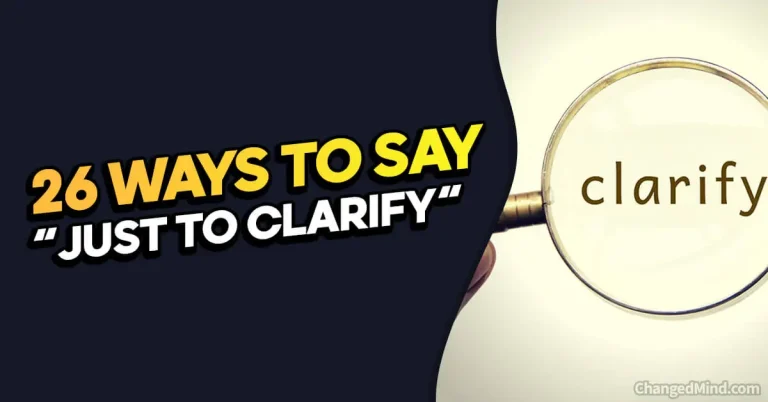Have you ever been in a situation where you’re about as patient as a cat waiting for a laser pointer to materialize?
We get it; the waiting game can be a real test of your zen-like abilities. But here’s the good news: in this article, we’re about to sprinkle some humor and creativity into your “Please Be Patient” arsenal.
We’ve gathered 26 delightful alternatives that will have you charming your way through those moments when patience is your best friend.
So, if you’re ready to add a pinch of wit and a dash of charm to your requests for patience, keep reading, because “Other Ways to Say ‘Please Be Patient'” is your ticket to mastering the art of waiting with style.
In this article, we’ll explore:
- Playful phrases to lighten the mood.
- Polite alternatives for courteous requests.
- Creative expressions to make your plea memorable.
- Insights into when and how to use these phrases effectively.
Get ready to transform your requests for patience into moments of charm and grace! Let’s dive into the world of polite and playful communication.
Patience is a virtue, especially when it comes to effective communication. The phrase “Please be patient” is commonly used to request understanding and tolerance. However, there are other ways to convey the same message while adding variety and nuance to your communication.
Understanding the importance of using alternatives to “Please be patient” in different situations can greatly enhance your interpersonal skills. Here’s why “Please be patient” is important in communication and some alternative phrases to consider.
Using “Please be patient” is crucial in communication as it acknowledges the value of time, respect, and understanding. It conveys a sense of empathy and helps maintain a positive environment for effective dialogue.
However, relying solely on this phrase can become repetitive and may lose its impact over time. By exploring alternatives, you can enhance your communication skills and contribute to a more engaging and respectful conversation.
Some alternatives to “Please be patient” include:
- “Thank you for waiting“: Expresses gratitude for the recipient’s understanding and cooperation.
- “I appreciate your patience“: Conveys a sense of recognition and gratitude for the recipient’s willingness to wait.
- “Your understanding is valued“: Acknowledges the importance of the recipient’s comprehension and patience.
- “I understand it takes time“: Shows empathy by recognizing that the process or situation requires time and patience.
- “I’m grateful for your cooperation“: Expresses gratitude for the recipient’s willingness to cooperate despite the need for patience.
The choice of alternative phrases depends on the specific situation and the tone you wish to convey. Different phrases may be more suitable for formal situations, informal interactions, professional settings, or personal conversations. By recognizing these nuances and selecting the appropriate alternative, you can maintain positive communication while effectively asking for patience. Key takeaways:
Key takeaway:
- Thank you for your patience: Express gratitude to acknowledge someone’s patience and show appreciation for their understanding.
- I appreciate your understanding: Show respect and appreciation for someone’s ability to comprehend the situation and remain patient.
- Your cooperation is valued: Emphasize the importance of someone’s cooperation and highlight how their patience contributes to the success of a situation.
26 Other Ways to Say “Please Be Patient”
Here are 26 other ways to say “Please Be Patient”:
- “Kindly wait a moment.”
- “Give it some time, please.”
- “Hold on just a bit.”
- “Bear with us, please.”
- “Be patient, if you will.”
- “We’ll get there shortly.”
- “Stay with us for a while.”
- “A moment of your time.”
- “Your patience is appreciated.”
- “Let’s give it a little time.”
- “In just a moment, please.”
- “Your understanding is valued.”
- “We’ll be there soon.”
- “Hang tight for a sec.”
- “We’ll be right with you.”
- “Your patience is admired.”
- “Stay tuned for updates.”
- “Hold tight, please.”
- “Just a moment, please.”
- “We’re working on it.”
- “Your patience means a lot.”
- “Please give us a moment.”
- “We’ll be back in a jiffy.”
- “Stay put for a while.”
- “Thanks for your patience.”
- “Your waiting is appreciated.”
These phrases can help you politely request patience in various situations.
Why is “Please Be Patient” Important in Communication?
Patience is crucial in communication as it helps foster understanding, empathy, and respect between individuals. When we ask others to be patient, we are acknowledging the complexity of the communication process and the need for time to process information.

In a fast-paced world, impatience can lead to misunderstandings, frustration, and strained relationships. Asking for patience allows for a more thoughtful and measured response, promoting effective and meaningful communication.
It shows that we value the thoughts and opinions of others, creating a space for open dialogue and collaboration.
By practicing patience, we can actively listen, avoid interrupting, and give others the opportunity to express themselves fully.
It also encourages us to be more tolerant and understanding when faced with different perspectives or challenging conversations.
Alternatives to “Please Be Patient”
Looking for ways to convey your request for patience without using the same old phrase? Well, you’re in luck! In this section, we’ll explore some refreshing alternatives to saying “Please be patient”.
From expressing gratitude for waiting to valuing understanding and even acknowledging that great things take time, we’ve got you covered.
So, let’s dive in and discover creative ways to communicate your need for patience effectively and respectfully.
1. “Thank You for Waiting”
When communicating with others, it is important to acknowledge and appreciate their patience. One alternative phrase to use instead of “Please Be Patient” is “Thank You for Waiting.” This phrase expresses gratitude for the recipient’s understanding and shows that their time and patience are valued.
Using “Thank You for Waiting” is appropriate in various situations. In formal settings, such as professional correspondence or customer service interactions, it adds a polite tone and maintains a positive communication environment. In personal interactions, it exhibits respect and consideration for the other person’s time.
For example, in an email, you can say, “Thank you for waiting while we complete the task. We appreciate your patience, and we are working to ensure a quick and efficient resolution.”
By using phrases like “Thank You for Waiting,” you can effectively convey your message while maintaining a courteous and appreciative tone.
2. “I Appreciate Your Patience”
When communicating, it is vital to express gratitude for someone’s patience. By saying “I appreciate your patience,” you not only acknowledge their understanding but also show thankfulness for their willingness to wait. This particular phrase can be utilized in a variety of situations.
Within professional settings, maintaining a polite and respectful tone, especially in customer service, is crucial. Instead of simply requesting patience with the phrase “Please be patient,” employing the alternative phrase “I appreciate your patience” can foster a positive rapport with the customer.
It conveys the message that their time is valued and assures them that efforts are being made to fulfill their request promptly and efficiently.
In personal interactions, expressing gratitude for patience can strengthen relationships and exhibit empathy. For instance, if someone asks a reasonable question and you require a moment to find an answer, saying “I appreciate your patience” demonstrates that you value their understanding as you search for the information they need.
By using phrases such as “I appreciate your patience,” you convey respect, gratitude, and a dedicated commitment to delivering the best possible service or assistance in any given situation.
3. “Your Understanding is Valued”
When communicating with others, it is crucial to choose the right phrases to effectively convey your message. In situations where you require patience, instead of saying “Please be patient,” you can incorporate the phrase “Your understanding is valued.”
This particular phrase not only acknowledges the individual’s patience but also emphasizes the significance of their comprehension within the given situation.
The beauty of this alternative lies in its versatility. Whether in formal scenarios like professional correspondence or customer service, using the phrase “Your understanding is valued” helps maintain a polite and professional tone. Likewise, in more casual settings, it serves as a courteous way to request someone’s patience.
In order to ensure positive communication while seeking patience, it is essential to provide reassurance and keep the person well-informed about the progress. For instance, in an email, you could express gratitude by saying, “Thank you for your understanding.”
We are diligently working towards completing the task and will provide an update shortly.”
By incorporating alternative expressions like “Your understanding is valued” instead of solely relying on “Please be patient,” you can effectively communicate your request while maintaining a polite and respectful tone.
4. “I Understand it Takes Time”
- Start with gratitude: Begin by expressing appreciation for the individual’s patience, such as “Thank you for your understanding.”
- Empathize with the situation: Acknowledge that the task at hand may require time and effort, stating “I understand it takes time to complete this task.”
- Provide reassurance: Reassure the person that their patience will lead to a satisfactory outcome, such as “I assure you that the final result will be worth the wait.”
- Stay communicative: Keep the person updated on the progress, offering regular updates or estimated timelines for completion.
- Offer assistance: If possible, offer any support or alternatives to expedite the process, showing a proactive approach.
- End with gratitude: Conclude the communication by expressing gratitude once again, thanking them for their patience and cooperation throughout the process.
5. “I’m Grateful for Your Cooperation”
In mathematics, the derivative is a measure of how a function changes as its input changes. Loosely speaking, a derivative can be thought of as how much the output of a function changes when we change the input by a very small amount. The process of finding derivatives is called differentiation.
The derivative of a function at a point is represented by the slope of the tangent line to the graph of the function at that point.
When to Use Different Phrases for “Please Be Patient”?
Looking for alternatives to the phrase “Please be patient”? In this section, we’ll explore when and where to use different phrases for conveying the same message.
Whether you’re in a formal situation, informal setting, professional environment, or engaged in personal interactions, we’ll uncover the best language choices for expressing patience.
No matter the context, we’ve got you covered with a range of options to effectively communicate your desire for understanding.
1. Formal Situations
In formal situations, it is imperative to maintain professionalism and effectively convey the message of “please be patient.”
Rather than repeatedly using the same phrase, there are various alternative ways to express this while upholding a courteous tone. Here are a few examples to consider:
- Thank you for your patience: This expresses gratefulness for the individual’s understanding and willingness to wait.
- I greatly appreciate your patience: This communicates sincere acknowledgment and gratitude for the person’s patience.
- We value your understanding: This conveys high regard and importance for the person’s patient behavior.
- I understand that this may take some time: This exhibits empathy and recognition that the task we are dealing with requires a certain amount of time.
- Your cooperation is highly appreciated: This shows sincere gratitude for the person’s cooperation and understanding throughout the process.
Pro-tip: When utilizing alternate phrases for “please be patient,” it is vital to maintain a polite and respectful tone. This approach helps foster positive relationships and effective communication within professional environments.
2. Informal Situations
In informal situations, there are several alternative phrases you can use instead of “Please Be Patient” to maintain a positive and friendly tone:
- Thank You for Waiting: Show gratitude and acknowledge the person’s patience.
- I Appreciate Your Patience: Express your appreciation for their understanding and cooperation.
- Your Understanding is Valued: Highlight the importance and value of their understanding.
- I Understand it Takes Time: Demonstrate empathy and let them know you understand the need for time.
- I’m Grateful for Your Cooperation: Convey gratitude for their cooperation and willingness to wait.
Using these alternatives in informal situations will help create a more relaxed and friendly atmosphere. For example, you can say “Thank you for waiting, I appreciate your patience” when asking someone to wait for you outside a café.
The key is to choose the appropriate phrase that matches the context and tone of the interaction, ensuring effective communication while maintaining a casual atmosphere.
3. Professional Settings
In professional settings, it is vital to communicate with a polite and respectful tone when requesting someone’s patience.
Utilizing alternative phrases to “please be patient” can assist in maintaining positive communication. Here are several examples:
1. “We appreciate your understanding during this process.”
2. “We value your patience as we work towards completing this task.”
3. “Your cooperation is greatly appreciated as we address this matter.”
4. “We understand that waiting can be frustrating, and we want to assure you that we are working as quickly and efficiently as possible.”
5. “We are grateful for your patience as we determine the best course of action.”
Implementing these phrases in professional correspondence, such as email, can foster a positive work environment and demonstrate that you respect the other person’s time. Remember, always maintain an appropriate tone and provide updates if necessary to keep them informed.
Pro-tip: When asking for patience, offering a timeframe or alternative solutions can also help manage expectations and exhibit your commitment to promptly resolving the issue.
4. Personal Interactions
In personal interactions, it is equally important to effectively and politely communicate the need for patience. A few alternative phrases to use when asking someone to be patient include:
| 1. “Please wait a while”: | This phrase not only acknowledges the person’s request but also expresses the need for additional time to complete the task. |
| 2. “Thank you for your patience”: | This demonstrates gratitude for the individual’s understanding and cooperation during the waiting process. |
| 3. “I appreciate your understanding”: | This conveys a sense of gratitude for the person’s empathy and willingness to be patient. |
| 4. “I understand it takes time”: | By using this phrase, you acknowledge that patience is necessary and show empathy towards the time required for the task at hand. |
To maintain positive communication in personal interactions, it is essential to use an appropriate tone of voice and demonstrate empathy towards the other person’s feelings and expectations. Additionally, providing regular updates on the progress or expected timeframe for completion can be helpful.
Remember, every situation is unique, so customizing your approach and finding your own phrases that convey patience is always beneficial in personal interactions.
How to Maintain Positive Communication While Asking for Patience?
To maintain positive communication while asking for patience, follow these steps:
- Express empathy: Acknowledge the other person’s feelings and let them know you understand their frustration.
- Use polite language: Be courteous and respectful in your request for patience.
- Provide a timeframe: Give an estimated timeline for when the issue will be resolved.
- Offer updates: Keep the person informed of any progress or changes.
- Show gratitude: Thank the person for their understanding and patience.
During the construction of the Eiffel Tower, its completion was delayed due to labor strikes and technical challenges. The project manager, Gustave Eiffel, maintained positive communication with the workers and the public.
He regularly updated people on the progress and addressed their concerns with empathy and understanding.
Despite the delays, the Eiffel Tower was eventually completed and became an iconic symbol of Paris and a testament to the power of positive communication during challenging times.
To maintain positive communication while asking for patience, follow these steps:
- Express empathy: Acknowledge the other person’s feelings and let them know you understand their frustration.
- Use polite language: Be courteous and respectful in your request for patience.
- Provide a timeframe: Give an estimated timeline for when the issue will be resolved.
- Offer updates: Keep the person informed of any progress or changes.
- Show gratitude: Thank the person for their understanding and patience.
During the construction of the Eiffel Tower, its completion was delayed due to labor strikes and technical challenges.
The project manager, Gustave Eiffel, maintained positive communication with the workers and the public, demonstrating how to maintain positive communication while asking for patience. He regularly updated people on the progress and addressed their concerns with empathy and understanding.
Despite the delays, the Eiffel Tower was eventually completed. The construction process serves as an example of how positive communication can be utilized when asking for patience and understanding in challenging circumstances.
Some Facts About Other Ways to Say “Please Be Patient”:
- ✅ “Thank you for your patience” is a common and polite way to ask someone to be patient. (Source: Our Team)
- ✅ “Your patience is appreciated” is a formal alternative to “please be patient”. (Source: Word Selector)
- ✅ “Please bear with me” can be used as an informal synonym for “please be patient”. (Source: Word Selector)
- ✅ “Please wait a second” and “please hold on a minute” are other ways to ask for patience. (Source: Word Selector)
- ✅ “Just a moment” and “please hold on” can also be used as alternatives to “please be patient”. (Source: Word Selector)
Frequently Asked Questions
1. What are some other ways to say “please be patient”?
Some alternative phrases to politely ask someone to be patient include “your patience is appreciated,” “please bear with me,” “please wait a second,” “please hold on a minute,” “just a moment,” “please hold on,” “thank you for your patience,” “thank you for waiting,” “this should just take a while longer,” “please wait a while,” and “hang tight.”
2. Is it important to use the conventional phrasing when asking someone to be patient?
Using the conventional phrase “thank you for your patience” is advantageous as people are more likely to accept it without much thought. Creating a new phrase may lead people to analyze its literal meaning and intentions.
3. Can I invent my own polite phrase to ask for someone’s patience?
While it is possible to create your own polite phrase, others may question its meaning and intentions. It is generally more acceptable to use the conventional and widely recognized phrases.
4. Are there any grammar mistakes in saying “please be patient”?
No, “please be patient” is grammatically correct and suitable for use in a professional environment. It is a conventional and less demanding way to ask for patience.
5. How can I politely ask a long-term client to remain patient while I figure something out?
You can say, “Thank you for your continued support. I am currently working on finding an answer/solution and appreciate your patience while I figure this out. Please hold on, and I will get back to you soon.”
6. Can you provide an example of an email where “your patience is appreciated” is used to address a delayed order?
Sure!
Subject: Apology for Delayed Order
Dear Mr. Clarke,
We sincerely apologize for the delay in processing and delivering your order. Your patience is greatly appreciated, and we understand the inconvenience this may have caused.
Rest assured, our team is working diligently to complete the task and fulfill your order as soon as possible. We value you as a long-term client and are committed to providing the highest level of service.
Thank you again for your understanding and for being patient with us. If you have any further questions or concerns, please do not hesitate to reach out to us.
Best regards,
Danny Redford






